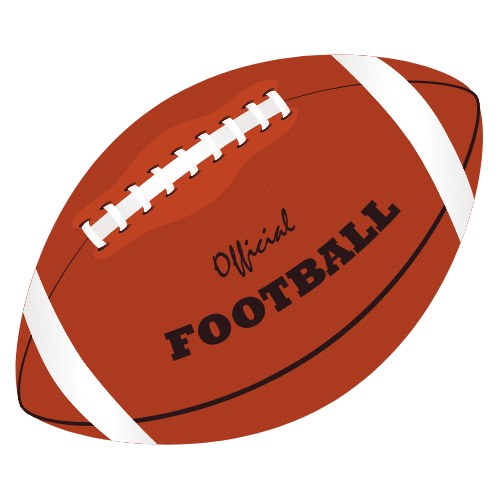Rule 3 - Periods, Time Factors and Substitutions
SECTION 3. Timeouts: Starting and Stopping the Clock
Article 1 - Timeout
a. An official shall signal timeout when the rules provide for stopping the clock or when a timeout is charged to a team or to the referee. Other officials should repeat timeout signals. The referee may declare and charge himself with a discretionary timeout for any contingency not elsewhere covered by the rules. (A.R. 3-3-1:IV)
b. When a team’s charged timeouts are exhausted and it requests a timeout, the officials shall not acknowledge the request (Rule 3-3-4).
c. Once the game begins, players shall not practice with a ball on the field of play or the end zones except during the half-time intermission.
Article 2 - Starting and Stopping the Clock
If the margin in the score becomes more than 34 points, a running clock session will start. During a running clock session, the game clock will stop only for reasons marked * below. For other events listed here, the clock will keep running. Competitions may adopt regulations to:
1. forgo the running clock rule completely;
2. forgo the rule only in the first half of a game;
3. limit the running clock rule to use after an elapsed time no later than 2 hours 15 minutes after kickoff, but only in games that are broadcast live;
4. reduce the score margin below 34 points.
a. Free Kick. After the ball is free-kicked, the game clock shall be started on an official’s signal when the ball is legally touched in the field of play, or when it crosses the goal line after being touched legally by Team B in its end zone. It is subsequently stopped on an official’s signal when the ball is dead by rule. (A.R. 3-3-2:VII)
b. Scrimmage Down. When a period begins with a scrimmage down, the game clock shall be started when the ball is legally snapped. On all other scrimmage downs, the game clock shall be started when the ball is legally snapped (Rule 3-3-2-d) or on a prior signal by the referee (Rule 3-3-2-e). The game clock shall not run during a try, during an extension of a period or during an extra period. (A.R. 3-3-2:I-IV)
c. After a Score. The game clock shall stop on an official’s signal after a touchdown, field goal or safety. It shall be started again as in (a) above unless an accepted penalty erases the score or the down is repeated in which cases it shall be started when the ball is legally snapped.
d. Starts on the Snap. For each of the following, the game clock is stopped on an official’s signal. If the next play begins with a snap, the game clock will start on the snap:
1. Touchback (provided Team B will next snap the ball).
2. With fewer than two minutes remaining in a half a Team A ball carrier, fumble or backward pass is ruled out of bounds. (Exception: After a Team A forward fumble goes out of bounds, the clock starts on the referee’s signal.)
3. Team B is awarded a first down and will next snap the ball. (A.R. 3-3-2:V)
4. A forward pass is ruled incomplete.
5. A team is granted a charged timeout. *
6. The ball becomes illegal. *
7. A period ends. *
8. A legal kick down ends. (A.R. 3-3-2:VI)
9. A return kick is made.
10. A scrimmage kick is made beyond the neutral zone.
11. Team A commits a delay-of-game foul while in a scrimmage kick formation.
e. Starts on the Referee’s Signal. For each of the following reasons, the game clock is stopped on an official’s signal. If the next play begins with a snap, the game clock will start on the referee’s signal:
1. Team A is awarded a first down, either through play or by penalty.
2. A Team A forward fumble goes out of bounds.
3. Other than with fewer than two minutes remaining in a half, a Team A ball carrier, fumble or backward pass is ruled out of bounds.
4. To complete a penalty (Exception: Rule 3-4-5-b). *
5. An injury timeout is allowed for one or more players or an official. (A.R. 3-3-5:I-V)*
6. An inadvertent whistle is sounded.
7. A possible first-down measurement. *8. Both teams cause a delay in making the ball ready for play (A.R. 3-3-1:III).
9. A live ball comes into possession of an official.
10. A head coach requests a conference or video review. *
11. The referee grants a media timeout. *
12. The referee declares a discretionary timeout. *
13. The referee declares a timeout for unfair noise (Rule 9-2-1-b-5).
14. An illegal pass is thrown to conserve time (A.R. 7-3-2:II-VII) (Exception: Rule 3-4-5-b).
15. The referee interrupts the 40/25-second count.
16. A player’s helmet comes completely off through play.
17. When either team commits a dead-ball foul. *
f. Snap Supersedes Referee’s Signal. Whenever one or more incidents that cause the game clock to be started on the referee’s signal (Rule 3-3-2-e) occur in conjunction with any that cause it to be started on the snap (Rules 3-3-2-c and 3-3-2-d), it shall be started on the snap. (Exception: Rule 3-4-5 (10-second runoff) supersedes this rule, other than when a team is granted a charged timeout. (A.R.3-3-2:VIII-IX)
g. Running clock.
1. During a running clock session, the clock will always be started on the ready for play rather than the snap. (A.R. 3-3-2:X-XI)
2. If during a running clock session, the margin in the score continues to be more than 34 points, the running clock session will continue. If the margin drops to 34 or fewer points, the running clock session will end immediately on the relevant score and normal clock rules will apply unless and until the margin becomes more than 34 points again. (Exception: If a competition reduces the score margin to start a running clock session below 34 points, the margin to end it will be similarly lower.)
Article 3 - Suspending the game
a. The referee may suspend the game temporarily when conditions warrant such action.
b. When the game is stopped by actions of a person(s) not subject to the rules, or for any other reasons not specified in the rules, and cannot continue, the referee shall:
1. Suspend play and direct the players to their team areas.
2. Refer the problem to those responsible for the game’s management.
3. Resume the game when conditions are satisfactory.
c. If a game is suspended under Rules 3-3-3-a and b before the end of the fourth period and cannot be resumed, there are four possible options:
1. Resume the game at a later date;
2. Terminate the game with a determined final score;
3. Forfeit of the game; or
4. Declare a no contest.
The option that takes effect shall be determined by competition regulations.
d. If a game is suspended under Rules 3-3-3-a and b after four periods of play and cannot be resumed, the game shall be ruled a tie. The final score shall be the score at the end of the last completed period. (Note: If a winner must be determined in a competition playoff game, competition regulations shall determine when and where the game will be resumed.)
e. A suspended game, if resumed, will begin with the same time remaining and under the identical conditions of down, distance, field position and player eligibility.
Article 4 - Charged Team Timeouts
When timeouts are not exhausted, an official shall allow a charged team timeout when requested by any player or head coach when the ball is dead.
a. Each team is entitled to three charged team timeouts during each half.
b. After the ball is declared dead and before the snap, a legal substitute may request a timeout if he is between the nine-yard marks. (A.R. 3-3-4:I)
c. A player who participated during the previous down may request a timeout between the time the ball is declared dead and the snap without being between the nine-yard marks. (A.R. 3-3-4:I)
d. A head coach who is in, or in the vicinity of, his team area or coaching box may request a timeout between the time the ball is declared dead and the next snap.
e. A player, incoming substitute or head coach may request a head coach’s conference with the referee if the coach believes a rule has been enforced improperly. If the rule enforcement is not changed, the coach’s team will be charged a timeout, or a delay penalty if all timeouts have been used.
1. Only the referee may stop the clock for a head coach’s conference.
2. A request for a head coach’s conference or video review must be made before the ball is snapped or free-kicked for the next play and before the end of the second or fourth period (Rule 5-2-9).
3. After a head coach’s conference or video review, the full team timeout is granted if charged by the referee.
Article 5 - Injury Timeout
a. In the event of an injured player(s):
1. An official will declare a timeout and the player(s) must leave the game. He must remain out of the game for at least one down, even if his team is granted a team timeout. When in question, officials will take a timeout for an injured player.
2. The player(s) may not return to the game until he receives approval of medical personnel designated by his team.
3. Officials, coaches and trainers shall give special attention to players who exhibit signs of a concussion. (See Appendix C.)
4. Whenever a participant (player or game official) is bleeding, has blood saturated on the uniform, or has blood on exposed skin, the player or game official shall go to the team area and be given appropriate medical treatment. He may not return to the game without approval of medical personnel. (A.R. 3-3-5:I-VII)
b. Feigning an injury for any reason is unethical. An injured player must be given full protection under the rules, but feigning an injury is dishonest, unsportsmanlike and contrary to the spirit of the rules. For questionable game action, a team or an official has the option to report the matter to the relevant disciplinary authority, who may choose to take action against the player(s) and coach(es) involved. Attention is directed to the statement in "The Football Code" (Coaching Ethics).
c. An injury timeout may follow a charged team timeout.
d. The referee will declare a timeout for an injured official.
e. Following a timeout for an injured player of the defensive team, the play clock shall be set at 40 seconds.
f. Ten-Second Runoff. If the player injury is the only reason for stopping the clock (other than his or a teammate’s helmet coming off, (Rule 3-3-9) with less than one minute in the half, the opponent has the option of a 10-second runoff.
1. The play clock will be set at 40 seconds for an injury to a player of the defensive team and at 25 seconds for an injury to a player of the offensive team (Rule 3-2-4-c-4).
2. Rule 3-4-5 applies. (A.R. 3-3-5:VIII and IX)
Article 6 - Violation Timeouts
Article 7 - Length of Timeouts
a. A charged full team timeout requested by any player or head coach shall be one minute plus the five-second referee notification and the 25-second play clock interval. (Exception: Rule 3-3-4-e-3).
b. Other timeouts shall be not longer than the referee deems necessary to fulfill the purpose for which they are declared, including a radio or TV timeout, but any timeout may be extended by the referee for the benefit of an injured player (Refer to Appendix A for the guidelines for game officials to use during a serious on-field player injury).
c. If the team charged with a full team timeout wishes to resume play before the expiration of one minute and its opponent indicates readiness, the referee will declare the ball ready for play.
d. The length of a referee’s timeout depends on the circumstances of each timeout.
e. Penalty options must be exercised before a team timeout.
f. The intermission after a safety, try or successful field goal shall be not more than one minute. It may be extended for radio or television.
Article 8 - Referee’s Notification
During a full team timeout (Rule 3-3-7-a) the referee shall notify both teams after one minute. Five seconds later the referee shall declare the ball ready for play.
a. When a third timeout is charged to a team in either half, the referee shall notify the field captain and head coach of that team.
b. Unless a visual game clock is the official timepiece, the referee also shall inform each field captain and head coach when two minutes or less of playing time remain in each half. He may order the clock stopped for that purpose. If the game clock is running at 2:00 and the ball is dead, the clock shall be stopped and the two-minute warning given then. If the ball is live at 2:00, the two-minute warning shall be given after the ball becomes dead.
1. The play clock may be interrupted for this purpose and shall then be reset to 25 seconds.
2. The clock starts on the snap after the two-minute notification.
3. Competitions may adopt regulations that even if a visual game clock is the official timepiece, a two-minute warning shall still be given.
c. If a visual game clock is not the official timing device during the last two minutes of each half, the referee or his representative shall notify each captain and head coach of the time remaining each time the clock is stopped by rule. Also, a representative may leave the team area along the limit line to relay timing information under these conditions.
Article 9 - Helmet Comes Off — Timeout
a. If a player’s helmet comes completely off through play, other than as the direct result of a foul by an opponent, the player must leave the game for the next down. The game clock will stop at the end of the down. The player may remain in the game if his team is granted a charged timeout.
b. When the helmet coming off is the only reason for stopping the clock, other than due to an injury to the player or his teammate (Rule 3-3-5), the following conditions apply (A.R. 3-3-9:I-III):
1. The play clock will be set at 25 seconds if the player is on offense and at 40 seconds if the player is on defense. With one minute or more remaining in either half, the game clock will start on the referee’s signal.
2. Ten-Second Runoff. If there is less than one minute in the half the opponent has the option of a 10-second runoff, unless the helmet comes off as the direct result of a foul by the opponent. Rule 3-4-5 applies.
c. If the ball carrier’s helmet comes off as in paragraph a (above) the ball is dead (Rule 4-1-3-q). If the player is not the ball carrier the ball remains alive, but he must not
continue to participate in the play beyond the immediate action in which he is engaged. Prolonged participation is a personal foul (Rule 9-1-17). By definition such a player is obviously out of the play (Rule 9-1-12-b).



